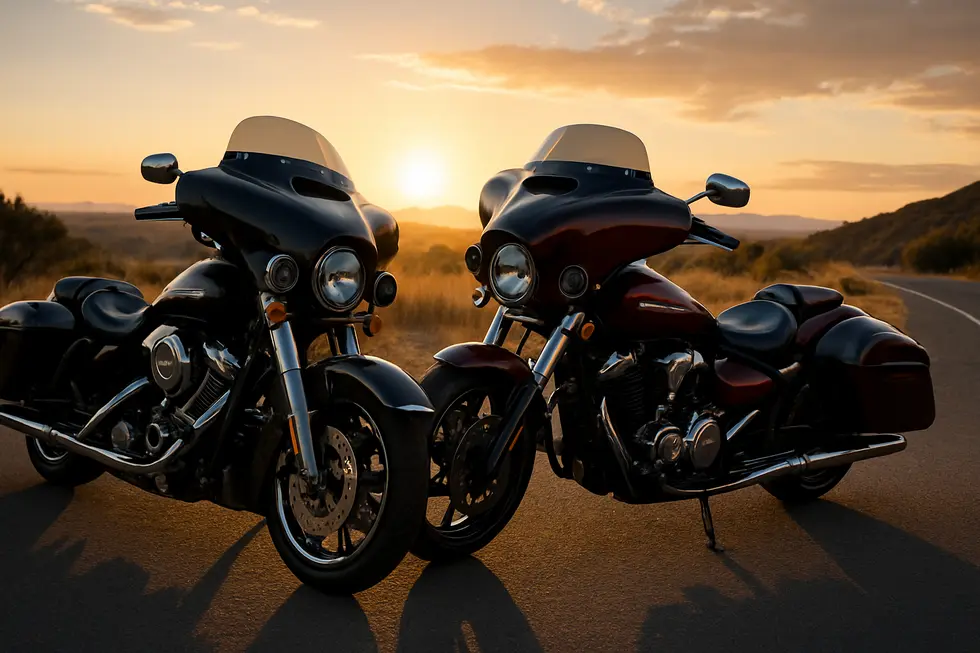Motorcycle Fairing Protection Film: Essential Shield for Business Success
October 13, 2025 | by summitfairings
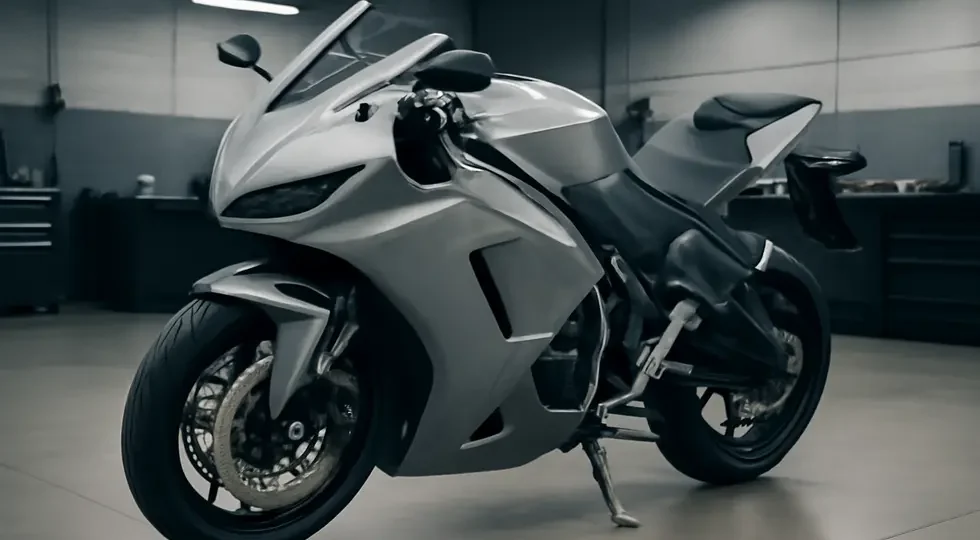
Introduction
For business owners in the motorcycle industry, maintaining the pristine condition of customers’ bikes is paramount—not only for reputation but also for ensuring long-term value. Motorcycle fairing protection film offers a clear, durable solution that guards painted surfaces against scratches, chips, and everyday road hazards while preserving the bike’s authentic appearance. This article delves into the key aspects business owners must understand: the protective benefits and value proposition it brings, expert application techniques that guarantee flawless installation, the longevity and maintenance required to uphold performance, and the customizable visual effects that complement diverse client preferences. Together, these insights lay the foundation for leveraging fairing protection film as a strategic business advantage in the competitive motorcycle aftermarket.
Tables of Contents
Chapter 1: Purpose and Benefits of Motorcycle Fairing Protection Film
- Technological Innovations and Material Excellence Elevating Motorcycle Fairing Protection
- Preserving Value and Culture: The Economic and Societal Impact of Motorcycle Fairing Protection Films
Chapter 2: Mastering Application Techniques for Motorcycle Fairing Protection Film
- Essential Surface Preparation and Wet Installation for Flawless Motorcycle Fairing Film Application
- Mastering Film Handling, Squeegee Precision, and Curing for Flawless Motorcycle Fairing Protection
Chapter 3: Durability and Maintenance of Motorcycle Fairing Protection Film
- Innovative Materials and Technologies Enhancing Longevity and Care of Motorcycle Fairing Protection Films
- Effective Care Practices and Environmental Impacts on Motorcycle Fairing Protection Film Longevity
Chapter 4: Customization and Visual Impact of Motorcycle Fairing Protection Film
- Merging Cutting-Edge Protection with Personalized Style in Motorcycle Fairing Films
- Elevating Motorcycle Aesthetics and Protection: How Fairing Films Transform Style and Function
Chapter 1: Purpose and Benefits of Motorcycle Fairing Protection Film
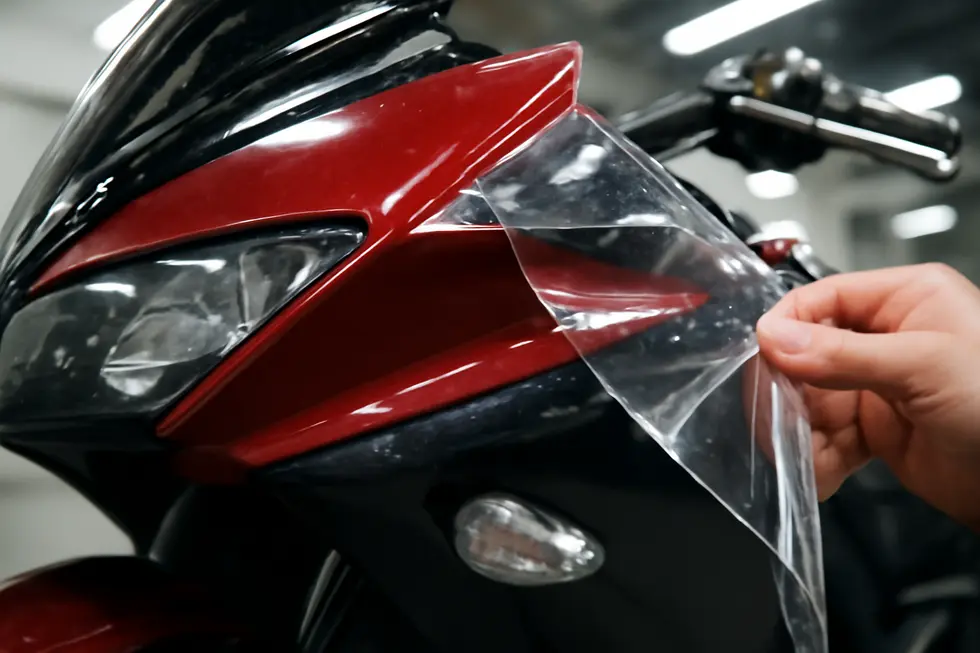
1. Technological Innovations and Material Excellence Elevating Motorcycle Fairing Protection
Motorcycle fairing protection film embodies a fusion of advanced technological features and superior materials that together redefine the standard for maintaining a motorcycle’s pristine appearance. At the heart of its technological innovation is the self-healing capability, a cutting-edge characteristic that enables minor scratches and scuffs to vanish when exposed to heat or sunlight. This dynamic property ensures that riders experience long-lasting visual clarity without the need for frequent touch-ups or refinishing, which is especially valuable given the rough conditions motorcycles often face.
Complementing this is the film’s near invisibility, designed to uphold the original aesthetic of the motorcycle. Whether the finish is glossy or matte, the film conforms seamlessly to every contour with no visible seams or bubbles, preserving the bike’s style while serving as an invisible shield. This subtlety also extends to UV protection, where the film acts as a barrier against sun damage that can cause paint fading and deterioration over time, an essential benefit for motorcycles frequently exposed to sunlight.
From a materials perspective, most fairing protection films utilize durable polyurethane, selected for its toughness and flexibility. This material resists a wide array of hazards, including scratches from road debris, chemical contaminants, and even bird droppings. The polyurethane layer effectively absorbs impacts that would otherwise mar the underlying paint, maintaining the paintwork’s integrity. Its longevity is substantial, often providing reliable protection for 5 to 10 years when installed with precision and care.
Proper application plays a critical role in maximizing these benefits. The film is custom-cut and meticulously applied to fit complex shapes and curves found in fairings, tanks, and fenders. Dividing the film into multiple pieces with carefully planned seams reduces stress and lifting, enhancing durability and visual appeal—as demonstrated in professional installations on intricate motorcycle models. Such expert applications ensure the film not only protects but also complements the design of the bike without altering its character.
Beyond protection, the film’s versatile nature allows riders to personalize their motorcycles without permanent modification. The adhesive quality means it can be removed cleanly, enabling temporary changes in finish or color without damage. This adaptability offers additional value to motorcycle enthusiasts seeking both protection and customization.
The strategic combination of these technological and material advantages reflects a comprehensive approach to motorcycle care. It safeguards critical painted surfaces while maintaining the bike’s original finish and resale value. For riders interested in exploring a range of motorcycle fairings and related protective solutions, this source on affordable motorcycle fairings offers valuable insight into options that align well with protection film applications.
Overall, the innovative technologies and robust materials embedded in motorcycle fairing protection films elevate their role from mere protective layers to essential components of motorcycle preservation and aesthetic enhancement.
2. Preserving Value and Culture: The Economic and Societal Impact of Motorcycle Fairing Protection Films
Motorcycle fairing protection film serves a critical role beyond merely shielding paintwork; it directly influences both the economic value of motorcycles and the broader cultural landscape of motorcycling communities. From an economic standpoint, applying this protective film reduces the financial burden associated with maintaining a motorcycle’s pristine appearance. Road debris, scratches from daily use, and ultraviolet light can cause significant damage to fairings, tanks, and fenders. Without protection, riders face costly repairs or frequent repainting to restore the original condition. By preventing such damage, protection film helps preserve the resale value of motorcycles, a crucial factor for owners of both new models and classic bikes whose worth heavily depends on condition authenticity. The film’s self-healing ability further limits the need for touch-ups by allowing minor abrasions to fade naturally with heat exposure, minimizing maintenance costs and extending the life of the protective layer.
These economic benefits ripple beyond individual owners and help stabilize the market for motorcycles. Maintaining original paintwork encourages investment in quality maintenance rather than premature replacement. This fosters a more sustainable approach to motorcycle ownership, as riders are incentivized to care for their machines longer and thereby reduce waste associated with frequent repainting or parts replacement.
Beyond economics, the societal significance of motorcycle fairing protection films manifests in the preservation of cultural heritage. Classic motorcycles often hold sentimental and historical value, representing milestones of design and engineering that reflect broader social trends and technological advances. By protecting these motorcycles from deterioration, the film supports conservation efforts aligned with cultural preservation initiatives like those outlined in the Charter of Turin, which emphasizes safeguarding historic vehicles as a form of cultural heritage. This commitment ensures that motorcycles remain tangible artifacts for future enthusiasts, historians, and communities to appreciate, study, and celebrate.
Moreover, the application of protection film encourages a deeper respect for motorcycles as symbols of identity and craftsmanship. Riders and collectors alike benefit from preserving the aesthetics and integrity of their bikes, which fosters a sense of pride and connection within the motorcycling community. The near-invisible nature of the film means that protection comes without compromising the visual impact of custom finishes or unique paint jobs, thus allowing individuality to flourish alongside durability.
Ultimately, motorcycle fairing protection film acts as a bridge connecting practical economic advantages with larger cultural values. It helps maintain the bike’s market worth and supports the continuity of motorcycling traditions by preserving machines that embody both personal and historical significance. For riders interested in balancing protection with style and heritage, understanding and investing in fairing protection film emerges as a wise and forward-thinking choice.
For more insights on motorcycle bodywork customization and protection, exploring the variety of options available at Summit Fairings provides a valuable resource.
Chapter 2: Mastering Application Techniques for Motorcycle Fairing Protection Film
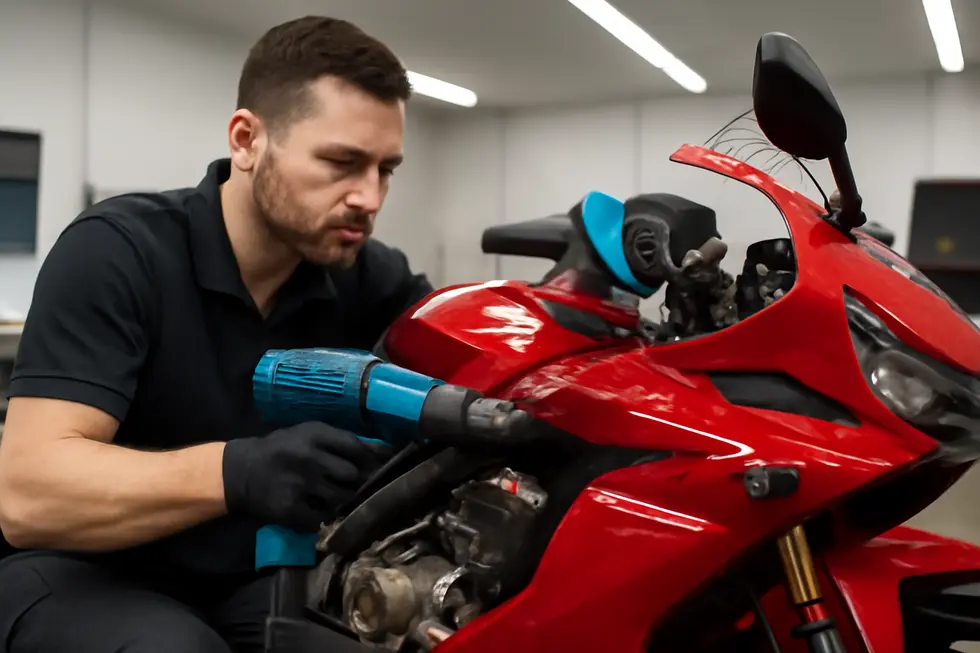
1. Essential Surface Preparation and Wet Installation for Flawless Motorcycle Fairing Film Application
Successful application of motorcycle fairing protection film begins with meticulous surface preparation and precise wet installation techniques. These steps are fundamental to achieving strong adhesion, long-lasting durability, and a seamless finish that preserves the motorcycle’s original aesthetics.
Surface preparation starts by thoroughly cleaning every inch of the fairings, tank, and fenders. Removing dirt, grease, wax, or any sealants is critical, typically using mild soap and soft cloths or sponges that won’t scratch delicate plastic surfaces. Once clean, the surfaces must be fully dried. For plastic fairings prone to oxidation or dullness, gentle wet sanding with ultra-fine grit sandpaper (1500–2000 grit) can help create a smooth, uniform surface that enhances film adhesion. It is equally important to wash and dry away all sanding residue before moving to the next step. Applying protection film over existing vinyl wraps or inadequately prepared surfaces can cause poor adhesion and bubbling, so the film performs best on original, factory paint or plastic. Any scratches or swirl marks should be polished out beforehand to avoid visible imperfections trapped beneath the film.
The wet installation technique plays a pivotal role in placing the film without bubbles, wrinkles, or distortion. A slip solution—a mixture of water and a small amount of soap or a commercially designed slip agent—is sprayed generously on both the film’s adhesive side and the motorcycle’s surface. This lubricated interface allows precise repositioning of the film before it bonds. Skilled installers then carefully stretch and shape the film to conform to complex curves and edges, maintaining the right balance to prevent overstretching (which causes failure) or under-stretching (which results in wrinkles). As the film settles, a squeegee is used to push out air bubbles and excess fluid, moving from the center toward the edges in firm, overlapping strokes to ensure a perfectly smooth finish.
Attention to detail in securing edges is crucial for longevity. Wrapping edges around corners rather than leaving them exposed reduces the risk of lifting and peeling over time. Environmental factors also matter; moderate temperatures and low humidity offer ideal conditions, making the film easier to handle and helping it adhere more effectively.
Because the application demands precision and experience, professional installation is highly recommended. Improper preparation, trapped debris, or incorrect stretching during DIY attempts often lead to premature film failure or unsightly results. Many professionals add a ceramic coating after film installation to enhance gloss, improve protection, and facilitate cleaning, extending the film’s lifespan.
By focusing on these detailed preparation and wet installation steps, installers can deliver a nearly invisible, durable shield that preserves the motorcycle’s finish and maintains the vehicle’s value. To explore further insights on motorcycle fairings and customization options, readers may find valuable information from an ultimate source for affordable motorcycle fairings useful.
Ensuring these foundational steps are thoroughly executed sets the stage for a professional-quality application that maximizes the protective benefits of motorcycle fairing protection film.
2. Mastering Film Handling, Squeegee Precision, and Curing for Flawless Motorcycle Fairing Protection
Applying motorcycle fairing protection film demands a blend of precision, patience, and knowledge of key handling and finishing techniques to achieve a flawless, durable finish. The film, usually crafted from flexible thermoplastic polyurethane (TPU), must be handled with utmost care from the moment it is unrolled. Avoiding contamination is essential; even minute dust particles or skin oils can compromise adhesion and diminish the film’s optical clarity. Preparing the motorcycle’s surface is equally critical — a pristine, scratch- and swirl-free base guarantees that the film adheres smoothly and reveals the original paint’s quality without distortion. Often, a thorough wash combined with targeted paint correction ensures the surface is perfectly ready for installation.
Using a wet installation method revolutionizes the application process by allowing the film to be repositioned with ease. A slip solution—typically water mixed with a small amount of mild soap—is sprayed onto both the motorcycle’s surface and the film itself. This technique reduces static cling and air bubbles, giving the installer freedom to adjust the film until it conforms seamlessly to even the most complex curves of tanks, fairings, and fenders.
The second cornerstone of flawless film installation lies in expert squeegee work. Employing a felt-covered or similarly soft squeegee ensures that the film is protected from scratching or tearing during the pressing process. The installer applies firm, consistent pressure as the squeegee pushes moisture and trapped air outward and off the edges of the film. This must be done methodically, beginning from the center and moving towards the edges to prevent wrinkles or bubbles and to guarantee a tight seal against the motorcycle’s contours. Smaller film sections and decals often require additional tools such as wide masking tape to hold pieces in place before smoothing with a squeegee, further enhancing precision.
Once the film is securely laid down, the curing phase begins—a decisive period where patience pays dividends. Initially, the film appears cloudy due to residual moisture beneath the surface, which naturally evaporates over time. Environmental factors such as temperature, humidity, and sunlight exposure can influence curing speed, with warm, sunny days accelerating this process. Generally, installers advise waiting at least 48 hours before exposing the bike to washing or harsh conditions to allow full adhesion and clarity development. If any large bubbles remain, this may signal improper installation and could necessitate remedial action.
For riders and installers aiming for the ultimate in protection and appearance, applying a ceramic coating over the cured paint protection film adds significant benefits. This additional layer enhances UV resistance, deepens gloss, and simplifies maintenance by repelling dirt and water, thereby extending the life of both the film and the paint beneath.
Ultimately, mastering film handling, squeegee technique, and curing management transforms the installation from a technical necessity into an art form, ensuring that the motorcycle’s finish remains impeccable and protected. For those interested in seeing these practices in action, detailed installation demonstrations can be found within professional communities and video resources that showcase expert methods on popular motorcycle models. For further exploring how these techniques complement the broader range of motorcycle fairings and accessories, discover insights at Summit Fairings.
Chapter 3: Durability and Maintenance of Motorcycle Fairing Protection Film

1. Innovative Materials and Technologies Enhancing Longevity and Care of Motorcycle Fairing Protection Films
Motorcycle fairing protection films are engineered marvels that combine advanced materials and cutting-edge technologies to ensure long-lasting durability while maintaining the original aesthetic appeal of the bike. At the core of these films is thermoplastic polyurethane (TPU), a flexible yet robust polymer prized for its resilience to impact and abrasion. TPU’s unique elasticity allows it to absorb the force of road debris and minor impacts, effectively shielding the paint beneath without cracking or peeling. This elasticity also facilitates a snug fit over complex curves, conforming perfectly to the contours of fairings, tanks, and fenders.
These films typically measure between 180 and 200 microns in thickness, striking a balance between protective strength and visual subtlety. Their optical clarity ensures that the original paint finish—whether glossy or matte—shines through undistorted, preserving the motorcycle’s visual integrity. Moreover, premium films feature hydrophobic topcoats, which repel water and minimize staining from environmental contaminants like mud, insects, and road salts. This property not only keeps the surface cleaner but also aids regular maintenance by reducing the buildup of grime.
One of the most remarkable innovations in fairing protection film technology is the introduction of self-healing capabilities. Minor surface scratches, often inevitable during regular use, can vanish with exposure to heat sources such as sunlight or warm water. This self-healing effect arises from the film’s elastic memory and specialized polymer coatings that restore the surface smoothness, greatly extending the film’s pristine appearance without intervention. While self-healing is highly effective for superficial abrasions, it cannot fully restore damage from deep cuts or heavy impacts, underscoring the importance of proper care and cautious riding.
UV resistance is another critical feature embedded in these films. Incorporated nano-scale UV blockers and inhibitors safeguard both the protective film and the underlying paint from harmful ultraviolet rays, significantly reducing the risk of fading, yellowing, or brittleness common with prolonged sun exposure. This UV protection ensures that vibrant paint colors retain their depth and gloss throughout years of outdoor use, preserving the motorcycle’s showroom finish.
Environmental resistance extends beyond UV shielding. The films are chemically resilient, able to withstand exposure to fuels, oils, insect remnants, and road salts without degradation. Their thermoplastic composition remains stable under wide temperature fluctuations, whether enduring scorching summer heat or cold winter rides. Such robustness guarantees that the film maintains adhesion and structural integrity under diverse climatic conditions.
To maximize the longevity of protection films, meticulous installation is paramount. Professional installation involves thoroughly cleaning and drying the surfaces, applying the film using wet installation methods that allow exact positioning, and carefully cutting and conforming the film to complex shapes. This process prevents air bubbles, lifting, or premature wear. Many manufacturers now offer pre-cut kits tailored to specific motorcycle models, streamlining the installation process and enhancing precision.
Maintenance is straightforward yet essential for sustained performance. Gentle cleaning with mild soaps and soft cloths avoids damaging the delicate hydrophobic coatings, while harsh chemicals and abrasive tools should be strictly avoided. Regular inspections enable early detection of any lifting edges or damage, allowing timely repairs or reapplication to prevent paint exposure.
Recent advancements push the boundaries further, merging nano-ceramic technologies with TPU to produce films that combine self-healing with heightened scratch resistance and heat tolerance. Options now include customizable finishes—from glossy to matte and specialty effects—without compromising durability. Additionally, environmentally conscious formulations reduce volatile organic compound emissions and enhance recyclability, reflecting growing industry commitment to sustainability.
By leveraging material science innovations and meticulous application techniques, motorcycle fairing protection films secure enduring defense against everyday hazards. Their ability to maintain aesthetic fidelity while providing a resilient, low-maintenance shield makes them an indispensable investment for riders committed to preserving their motorcycle’s value and appearance over time. For riders interested in exploring durable yet stylish body protection options, discovering choices at Summit Fairings can offer valuable inspiration and solutions.
2. Effective Care Practices and Environmental Impacts on Motorcycle Fairing Protection Film Longevity
Maintaining the durability of motorcycle fairing protection film requires a thoughtful balance between proper care practices and awareness of environmental influences. The film’s protective qualities depend heavily on how it is treated after installation and during regular use. Immediate care following application is crucial; the film’s adhesive needs a full 7 to 10 days to cure undisturbed. During this period, avoiding washing or exposure to water ensures the film bonds securely to the fairings, reducing the risk of premature lifting or peeling.
Once the film is fully cured, regular maintenance focuses on gentle cleaning techniques. Frequent hand washes with mild, pH-neutral soaps minimize abrasive damage and prevent chemical breakdown of the film’s surface. The widely recommended two-bucket wash method limits dirt particles from causing micro-scratches. Avoiding aggressive cleaners, waxes, or polishes is essential, as these products degrade the protective layer or leave residues that may dull the finish or reduce the film’s lifespan. Similarly, high-pressure water sprays should be avoided around the film’s edges to prevent lifting. Instead, use low-pressure rinsing and soft microfiber cloths to maintain the film’s integrity.
Environmental factors play a significant role in the film’s performance over time. Ultraviolet rays from sunlight are prime contributors to fading and degradation, making it important to limit prolonged direct sun exposure. Parking in shaded or indoor locations and using UV-blocking covers help preserve the film’s clarity and elasticity. Additionally, environmental contaminants such as salt air, dirt, rain, bird droppings, and tree sap accelerate wear by promoting oxidation, corrosion, or staining. Coastal environments, in particular, require more frequent yet gentle washings to remove corrosive salt deposits.
Advances in protection film technology, such as hydrophobic top coatings, enhance durability by repelling water and preventing contaminant buildup. Self-healing nano-ceramic layers further prolong the film’s flawless appearance by allowing minor scratches to vanish naturally with heat or sunlight exposure. These features reduce maintenance demands while improving resistance to environmental damage.
Prompt removal of aggressive contaminants is vital. Bird droppings and tree sap contain chemicals that can etch or weaken the film, so safely cleaning these off as soon as possible helps prevent lasting damage. Storage conditions impact longevity as well; films last longer when the motorcycle is kept in stable, cool, and dry environments that avoid extreme temperature swings or excessive dryness that may cause brittleness.
Ultimately, the best approach to preserving motorcycle fairing protection film combines cautious regular cleaning, avoidance of harsh products, environmental shielding, and the selection of advanced films designed to withstand natural wear. Such a holistic care strategy ensures the bike’s finish remains pristine and protected against the challenges of daily riding and environmental exposure. For riders seeking further insights into fairing care and protection, a valuable resource on environmental defense strategies for fairing protection films can be found at Summit Fairings blog.
Chapter 4: Customization and Visual Impact of Motorcycle Fairing Protection Film
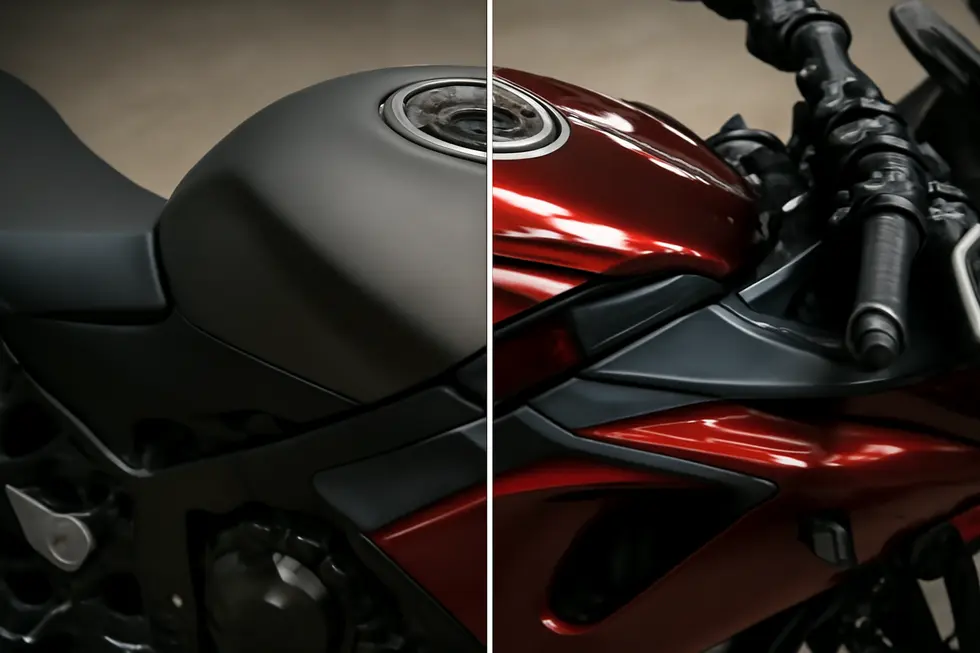
1. Merging Cutting-Edge Protection with Personalized Style in Motorcycle Fairing Films
Motorcycle fairing protection film masterfully blends advanced technology with personalized aesthetics, crafting a solution that serves both functional and stylistic demands. These films are made primarily from high-grade, colorless polyurethane known for its exceptional abrasion resistance and UV stability. Such materials withstand harsh environmental factors and everyday physical stresses, effectively preserving the motorcycle’s paintwork from stone chips, scratches, and chemical stains. Beyond simple durability, many protection films incorporate innovative self-healing properties, where minor surface abrasions and scuffs disappear with exposure to heat. This capability not only maintains the pristine appearance of the bike but also reduces the need for frequent touch-ups or repairs, delivering enhanced longevity for the finish beneath.
The application of protection films is a precise craft. These films are custom-cut to contour perfectly along the complex shapes of fairings, tanks, and fenders, ensuring a seamless fit that complements the motorcycle’s design rather than obscuring it. When installed by skilled professionals, the film adheres smoothly without bubbles or visible seams, preserving the original gloss or matte sheen that defines the bike’s character. Additionally, some high-quality films carry certifications that guarantee their resilience even under extreme conditions, such as high-speed riding and exposure to intense weather, underscoring their robustness and reliability.
On the aesthetic front, motorcycle protective films have evolved from simple clear shields into a diverse palette of finish options. Riders can choose from a range of surface textures such as matte for a stealthy, understated look, satin for a gentle sheen balancing gloss and flatness, or gloss to mimic the brilliant shine of freshly painted surfaces. Specialized options, including carbon fiber textured films, introduce a modern, high-tech flair while still delivering full protective benefits. Beyond finishes, color customization expands creative possibilities, allowing subtle enhancement of the existing paint or bold transformations that reflect the rider’s personality without compromising the underlying color.
Further customization is available via decals and stickers that utilize advanced air-release adhesive technology, which prevents bubbling during application. These elements can be layered over protected surfaces like tanks or helmets to add unique graphics or motifs that resonate with the rider’s style preferences.
The synergy between the film’s technical features and customizable design elevates motorcycle fairing protection from a mere safeguard to an expressive tool. It respects and preserves the craftsmanship of the bike while empowering riders to imprint their individuality. Tailored installations enhance original design lines or create reversible visual statements, maintaining resale value and prolonging aesthetic appeal.
Professional services specializing in protection film application ensure optimal fit and finish, often providing warranties. Such expertise is vital for achieving the perfect fusion of protection and style. For riders keen to explore extensive customization and protective options, resources like Summit Fairings offer a diverse selection of finishes and styles tailored to individual tastes and needs.
In summary, motorcycle fairing protection films represent an advanced convergence of technology and customization. They safeguard the bike’s finish with resilient, self-healing layers and UV resistance, while offering a spectrum of finishes and colors that enhance visual identity. This balance of durability and personalized style makes these films indispensable for modern motorcycle enthusiasts committed to protecting and expressing their bike’s essence.
2. Elevating Motorcycle Aesthetics and Protection: How Fairing Films Transform Style and Function
Motorcycle fairing protection films uniquely blend sophisticated material technology with creative customization, fundamentally transforming how riders preserve and personalize their machines. Far beyond mere surface shields, these clear polyurethane films empower riders to enhance their motorcycle’s aesthetics while offering resilient protection against the rigors of daily use. Each film is meticulously tailored to the precise contours of a bike’s fairings, tank, and fenders to ensure seamless coverage that preserves original paintwork without disruption. The careful custom cutting accommodates even complex curves, preventing wrinkles or peeling that can undermine both protection and appearance.
One of the most compelling benefits of fairing protection films lies in their blend of durability and subtlety. They guard against scratches, chips, and fading caused by road debris, UV rays, and environmental contaminants while remaining virtually invisible. This invisibility is crucial for riders who wish to retain the authentic look and finish of their motorcycle, whether that is a sleek gloss or refined matte. Furthermore, these films often feature self-healing properties, where minor abrasions disappear when exposed to heat or sunlight, restoring a pristine finish and reducing the need for repair or repainting.
Customization dimensions expand beyond protection, encompassing a range of finish options that cater to individual style preferences. Riders can select from glossy, matte, or even textured finishes like carbon fiber patterns, adding depth and visual interest without compromising the original paint. These aesthetic choices allow riders to express personality through subtle or bold enhancements, making each motorcycle uniquely their own. Moreover, the removable nature of the films maintains flexibility; they can be taken off without damaging the base paint, preserving resale value and allowing updates or changes as tastes evolve.
Integrating protection films with advanced treatments such as ceramic coatings further elevates both appearance and longevity. This combination enriches the paint’s clarity and gloss, improves resistance to stains and micro-scratches, and provides additional flexibility that combats cracking or peeling. The result is a resilient, luxurious finish that endures demanding conditions while requiring less maintenance.
Beyond their physical and aesthetic values, fairing protection films resonate deeply within motorcycle culture and broader societal trends. They reflect an ethos of pride in ownership and careful stewardship of valuable assets. The ability to protect and enhance visual appeal aligns with community values emphasizing personalization, sustainability, and property care. By prolonging the life of paintwork, these films reduce the demand for repainting and refinishing, lowering environmental impacts associated with chemical-intensive processes.
The popularity of protective films underlines a shift toward mindful customization—where function and fashion intersect for thoughtful, lasting results. As riders embrace these films, they contribute to vibrant, well-maintained urban and social environments, reinforcing a collective respect for craftsmanship and style. Furthermore, this demand fuels local businesses offering installation and customization, supporting specialized craftsmanship that enriches motorcycle communities.
The synthesis of protection, customization, and cultural significance embodied by motorcycle fairing protection films positions them as essential tools in modern motorcycling. For riders committed to both safeguarding and expressing their identity, these films offer a practical yet elegant solution that elevates the appearance and value of every ride. For insight into versatile options for enhancing your motorcycle’s exterior, exploring quality motorcycle fairings can complement these protective films beautifully, offering unmatched choices in style and fit.
Final thoughts
Motorcycle fairing protection film stands out as a powerful asset for business owners aiming to deliver unmatched value within the motorcycle market. From safeguarding the paint’s integrity against everyday hazards to providing durable surface protection that extends a bike’s aesthetic life, this film meets the highest standards of quality and practicality. Its professional application techniques ensure flawless, long-lasting coverage while minimizing the risk of failures that could harm customer satisfaction. Furthermore, the customizability of protection films allows businesses to meet varied client preferences without compromising the authentic look of each motorcycle. Embracing motorcycle fairing protection film strategically equips businesses with a competitive edge that combines protection, maintenance ease, and visual appeal—elements valued by riders and industry professionals alike.
Ready to elevate your ride? Summit Fairings delivers premium, custom-fit fairings that blend style and durability. Whether you’re chasing speed or turning heads, we’ve got your bike covered. Don’t wait—transform your machine today. Click, customize, and ride with confidence. Your perfect fairing is just a few clicks away. Act now!
About us
undefined
RELATED POSTS
View all



